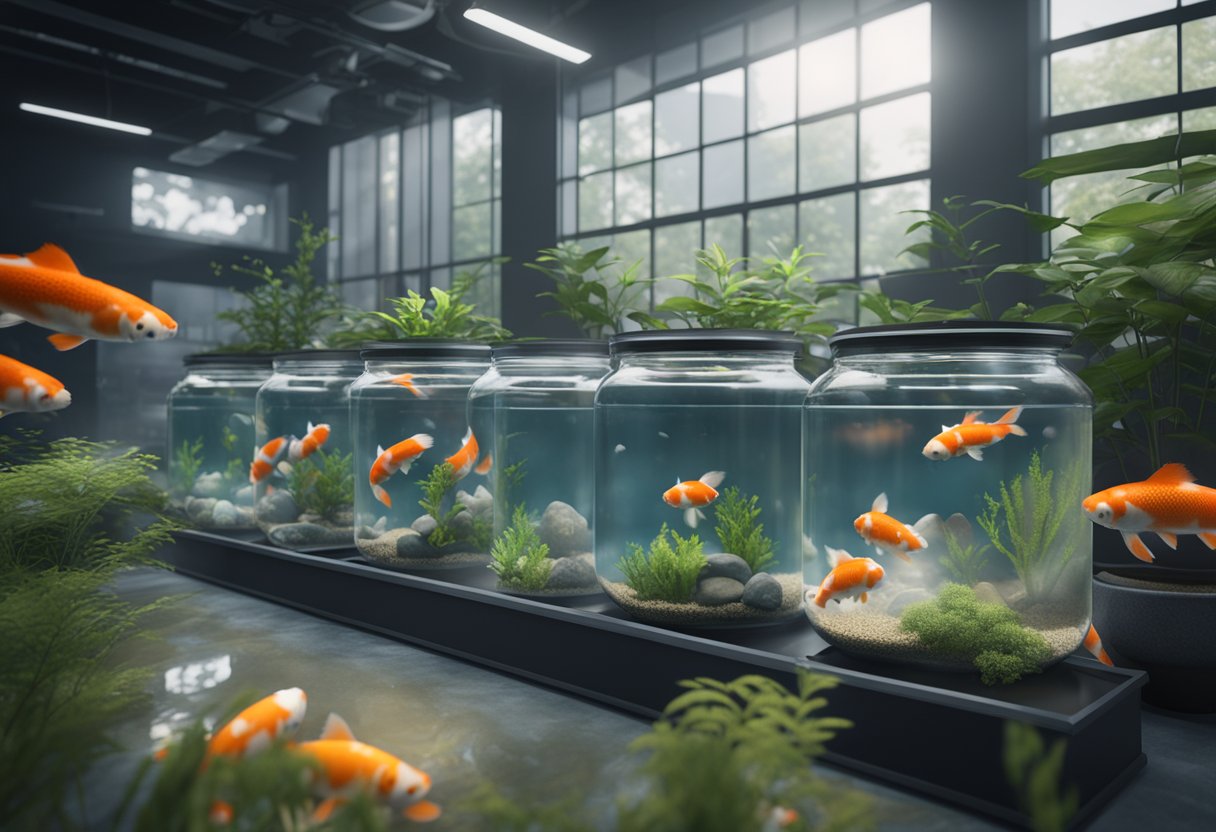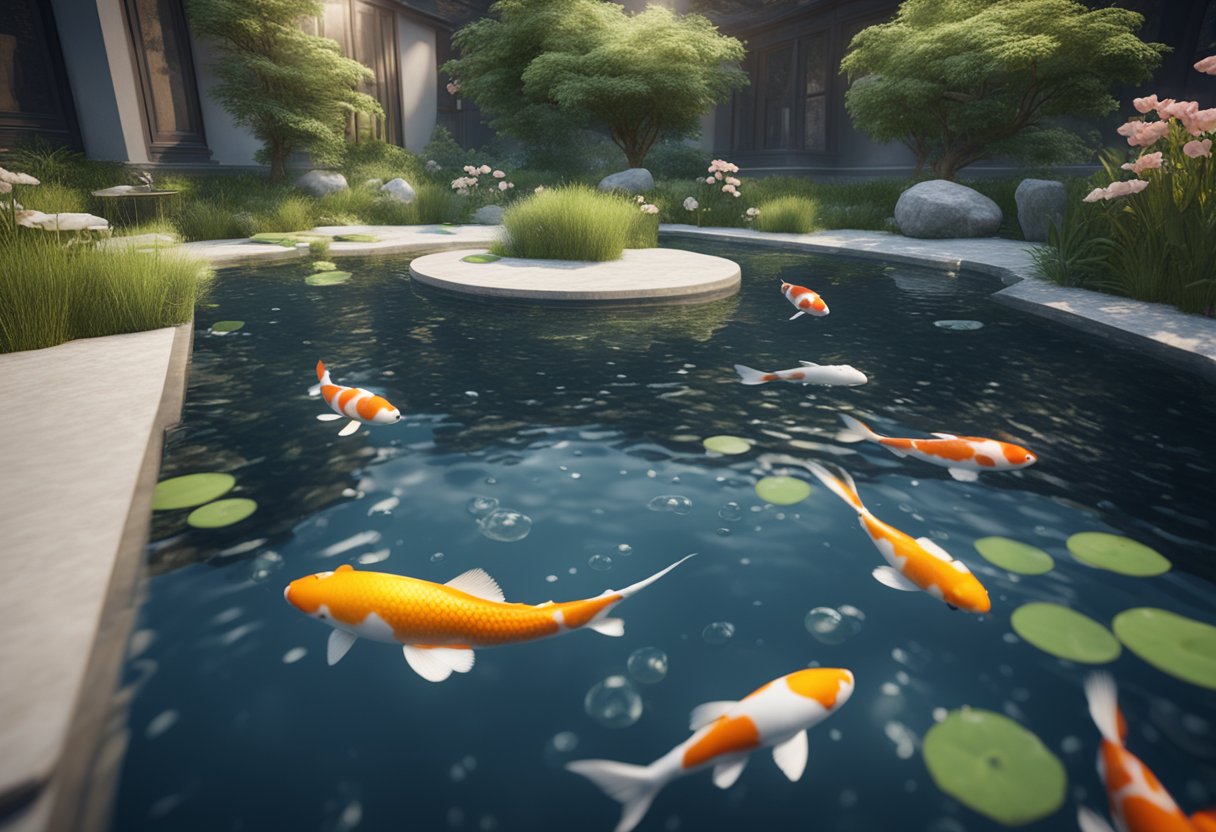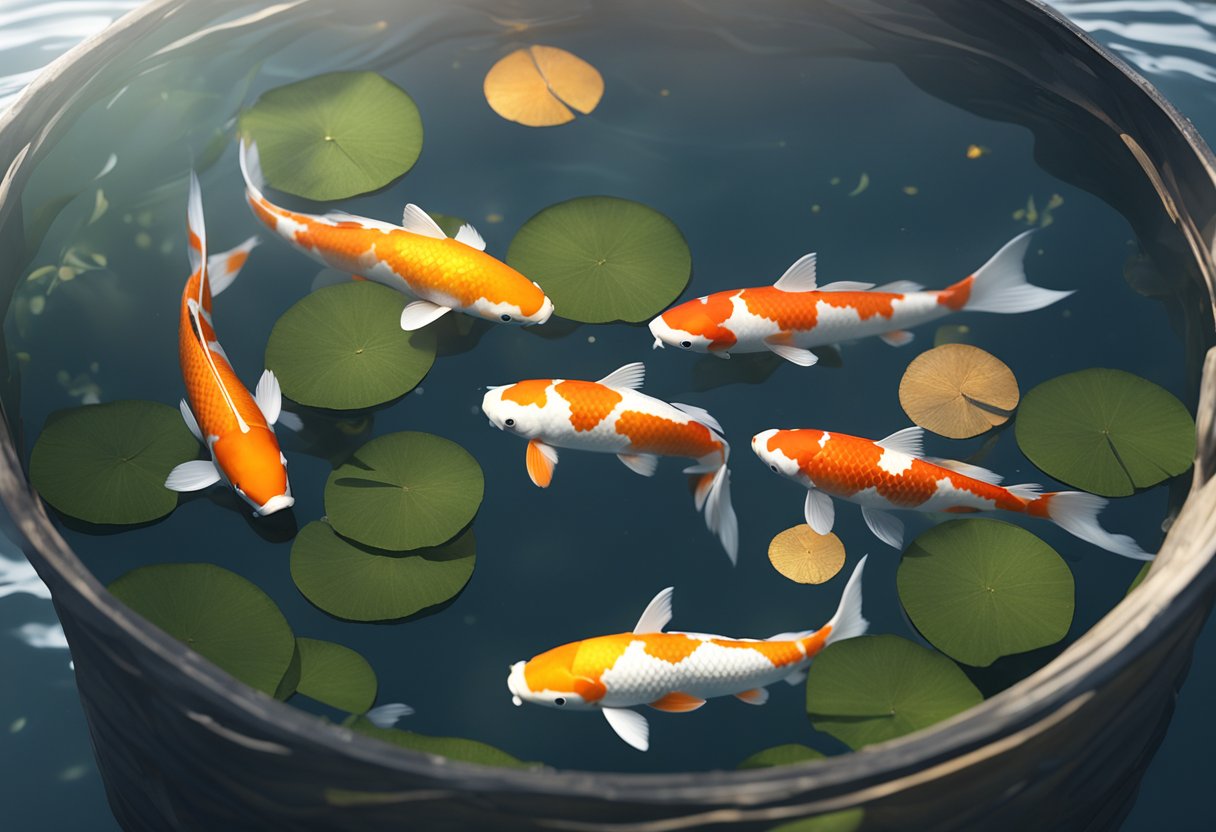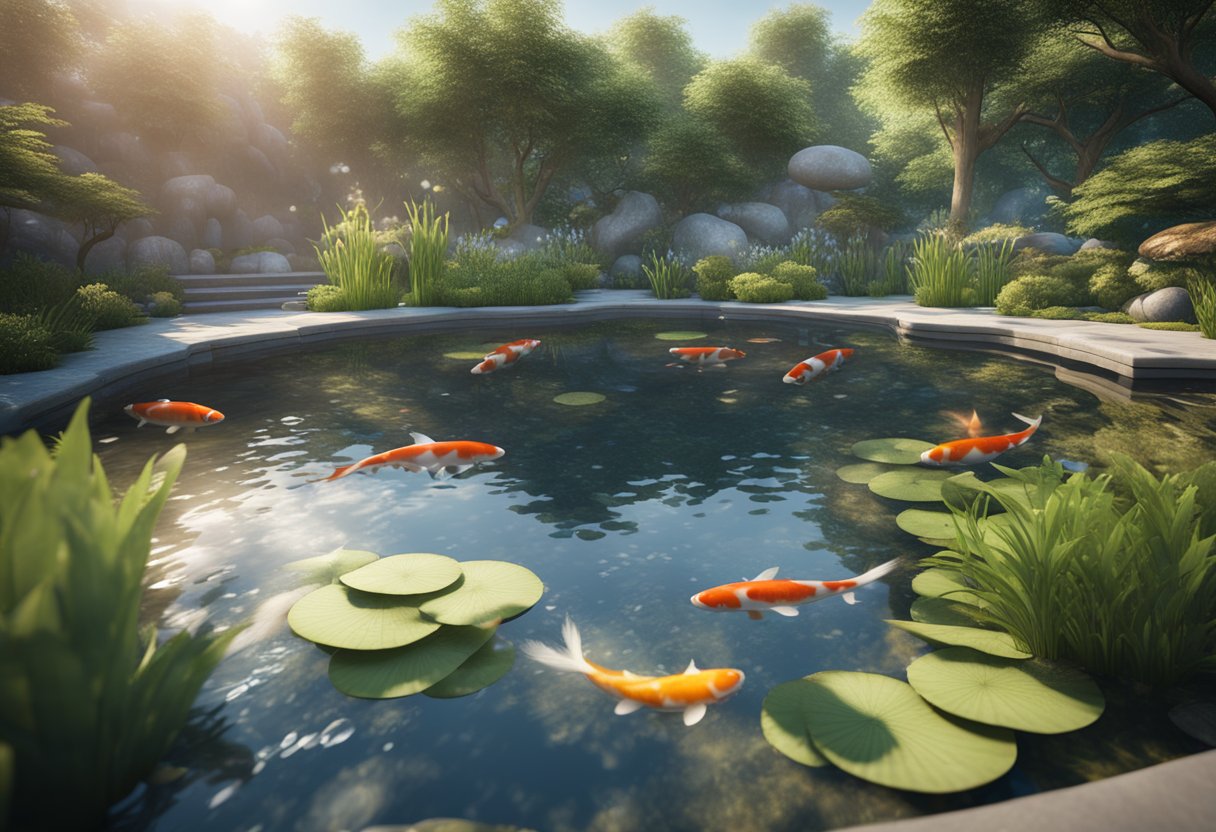Koi Temperature Regulation: Optimal Pond Conditions

By consistently monitoring the water temperature in your koi pond and utilizing the right tools and techniques, you can ensure that your fish thrive in the ideal conditions and respond promptly to any temperature changes that may impact their health.
| Tool | Pros | Cons |
|---|---|---|
| Digital Thermometers | Provides quick and accurate readings, easy to use | May require battery replacement, probe can get damaged |
| Dial Thermometers | Visible from a distance, suitable for larger ponds | General temperature range, may not provide precise readings |
| Infrared Thermometers | Non-intrusive, quick temperature checks | Limited to surface temperature readings, may not be as accurate |
| Wireless Sensors | Convenient, no need for direct monitoring | Requires proper positioning for accurate readings, may encounter connectivity issues |
Adjusting Temperature for Breeding and Health Conditions
Proper temperature regulation plays a crucial role in supporting successful breeding and maintaining optimal health conditions for koi fish. Understanding the specific temperature requirements for breeding and making necessary temperature adjustments are essential for the reproductive success of these beautiful aquatic creatures.
Koi fish are known to breed in water temperatures ranging from 64°F to 75°F (18°C to 24°C). It’s important to maintain these temperatures consistently within this range during the breeding season to stimulate spawning behavior and ensure the development of healthy eggs and fry.
During the breeding period, temperature adjustments can be made to encourage or discourage spawning activities. Slight increases in temperature can trigger spawning behavior, while slightly lowering the temperature can delay or prevent spawning.
For successful breeding:
- Maintain water temperature within the ideal range of 64°F to 75°F (18°C to 24°C).
- Gradually increase the temperature by 1-2°F (0.5-1°C) to stimulate spawning behavior.
- Provide adequate hiding places and suitable substrates for egg deposition.
- Monitor water quality parameters, such as pH and ammonia levels, to minimize stress and ensure a favorable environment for breeding.
- Remove any non-breeding koi from the breeding pond to reduce competition and potential stress.
It’s important to note that temperature adjustments should be made gradually to avoid shocking the fish and causing unnecessary stress. Observing the behavior of the koi during this time can also provide valuable insights into their readiness to spawn.
“Maintaining the ideal breeding temperature range is a critical factor in successful koi fish breeding. By carefully adjusting the temperature and providing optimum conditions, koi enthusiasts can increase the likelihood of successful spawns and the growth of healthy fry.” – Koi Breeding Expert, John Smith
Furthermore, temperature regulation is not only important for breeding but also for ensuring the overall health and well-being of the koi. When the water temperature is outside the recommended range, the fish may become stressed, making them more susceptible to diseases and compromising their immune system.
For maintaining optimal health conditions:
- Maintain the water temperature within the appropriate range for koi fish (68°F to 77°F or 20°C to 25°C) during non-breeding periods.
- Monitor the temperature regularly and make necessary adjustments to ensure stability.
- Provide adequate aeration and filtration to maintain water quality.
- Minimize temperature fluctuations, as rapid changes can be detrimental to the health of the fish.
By understanding the temperature requirements for breeding and taking necessary steps to maintain stable temperatures for optimal health, koi enthusiasts can provide the best possible conditions for their fish’s overall well-being.
| Recommended Temperature for Breeding | Recommended Temperature for Optimal Health |
|---|---|
| 64°F to 75°F (18°C to 24°C) | 68°F to 77°F (20°C to 25°C) |
Preventing Overheating: Summer Temperature Management
During the hot summer months, it is crucial to implement effective strategies to prevent the overheating of your koi pond. Overheating can have detrimental effects on the health and well-being of your koi fish.
Aeration for Temperature Control
Proper aeration plays a key role in maintaining the temperature of your koi pond. By promoting water circulation and adding oxygen, aeration helps to cool down the water and prevent heat stress in your fish. Consider installing a quality pond aerator or fountain system to enhance air exchange and keep the water temperature balanced.
Shade Provision
Providing adequate shade is another critical aspect of managing the summer temperature in your koi pond. Direct sunlight can rapidly increase the water temperature, stressing your fish and promoting the growth of harmful algae. Strategically place shade structures, such as floating plants or a pergola, to block the intense sunlight and create cooler areas for your koi to seek refuge.
Water Quality Management
Maintaining proper water quality is essential for temperature regulation in your koi pond. High water temperatures can accelerate the growth of bacteria, leading to water quality issues. Regular water testing, filtration maintenance, and partial water changes should be performed to ensure optimal water conditions and prevent spikes in temperature.
“Overheating can have detrimental effects on the health and well-being of your koi fish.”
By implementing these strategies for summer temperature management, you can create a comfortable environment for your koi fish and prevent overheating. Remember to regularly monitor the temperature in your pond and make adjustments as needed to maintain the ideal conditions for your beloved koi.
Winterizing Your Koi Pond: Cold Weather Preparations
As the colder months approach, it’s essential to take the necessary steps to winterize your koi pond and ensure the well-being of your fish. Cold temperatures can pose various challenges, including maintaining the ideal temperature and providing adequate care for your koi.
When it comes to maintaining koi pond temperature during winter, insulation is key. Insulating the pond helps to trap heat and prevent rapid temperature fluctuations that can stress or harm the fish. One effective method is to use insulating materials such as pond covers or floating thermal blankets. These materials create a barrier between the cold air and the pond, helping to maintain a stable temperature.
In addition to insulation, creating ice-free areas in the pond is crucial. Ice can limit the exchange of oxygen and harm the fish. To prevent ice formation, consider using a pond heater or aerator. These devices help to keep a part of the water surface ice-free, allowing for the necessary oxygen exchange and preventing the build-up of harmful gases.
Another vital aspect of cold weather koi care is ensuring proper filtration and oxygenation. During the winter, the metabolism of koi slows down, and they produce less waste. As a result, the demand for filtration decreases. However, it’s still important to maintain proper filtration to keep the water clean and oxygenated. Utilizing a low-flow filter or reducing the filtration duration can help achieve the right balance.
Proper winterization of your koi pond is essential for maintaining koi pond temperature and ensuring the well-being of your fish during the colder months.
Key Takeaways:
- Insulate your pond using pond covers or floating thermal blankets to maintain a stable temperature.
- Prevent ice formation by using a pond heater or aerator to create ice-free areas.
- Maintain proper filtration and oxygenation during winter, adjusting the flow and duration to accommodate the decreased waste production.
Risks Associated with Incorrect Temperature Regulation
Proper temperature regulation plays a crucial role in maintaining the health and well-being of koi fish in ponds. Failure to maintain the right temperature can expose koi to various risks and consequences that can negatively impact their overall vitality. Here, we explore the potential hazards associated with incorrect temperature regulation and underline the importance of maintaining optimal conditions for these beautiful aquatic creatures.
1. Stress and Discomfort
When koi fish are subjected to extreme temperatures or frequent temperature fluctuations, it can lead to significant stress and discomfort. Temperature imbalances can disrupt their natural biological rhythms and physiological processes, causing the fish to become agitated, anxious, and prone to erratic behavior.
2. Weakened Immune System
Koi fish that are exposed to prolonged periods of suboptimal temperatures may experience a weakened immune system. The immune response of koi fish is highly dependent on temperature, and deviations from their optimal range can impair their ability to fight off infections and diseases effectively. As a result, koi fish may become more susceptible to various illnesses and infections.
3. Increased Vulnerability to Diseases
Incorrect temperature regulation can increase the vulnerability of koi fish to a wide range of diseases. Fluctuations in temperature can stress the fish and compromise their immune system, making them more susceptible to bacterial, viral, and parasitic infections. Additionally, sudden changes in temperature can disrupt the balance of beneficial bacteria in the pond, further increasing the risk of disease outbreaks.
4. Growth and Development Issues
The growth and development of koi fish can be hindered by inconsistent or incorrect temperature conditions in their pond. Suboptimal temperatures can slow down their metabolic processes, leading to delayed growth and development. This can result in stunted growth, reduced size, and compromised overall body condition of the fish.
“Maintaining a stable and optimal temperature in a koi pond is essential for ensuring the well-being and longevity of the fish. Temperature imbalances can have severe consequences, including stress, weakened immune system, increased susceptibility to diseases, and growth issues.”
It is crucial for koi pond owners to prioritize temperature regulation and implement proper tools and techniques to maintain stable conditions. By doing so, they can protect their koi fish from the potential risks associated with incorrect temperature regulation and provide them with a comfortable and healthy environment to thrive in.
Conclusion
In conclusion, maintaining optimal temperature conditions in koi ponds is crucial for the overall well-being and health of the fish. The ideal temperature range for koi fish ensures proper metabolic functioning, immune system strength, and reproductive success. Constant monitoring and regulation of water temperature throughout the seasons are essential to prevent temperature fluctuations that can cause stress and compromise the fishes’ immune systems.
Stable water temperature minimizes the risk of diseases, enhances growth and vitality, and promotes successful breeding. Various methods for controlling koi pond temperature, such as using heaters, shade structures, and natural shading techniques, are effective in maintaining the desired temperature range.
During colder months, proper winterization techniques, including insulation, ice-free areas, and adequate filtration, are essential to protect the fish from extreme cold temperatures. Similarly, in hot summer months, preventing overheating through proper aeration, shade provision, and water quality management is crucial.
By understanding the risks associated with incorrect temperature regulation, koi fish enthusiasts can take proactive measures to maintain optimal pond conditions. Regular monitoring and adjustments to temperature, particularly during breeding seasons or health conditions, ensure the continued well-being and longevity of these beautiful and captivating aquatic creatures.




